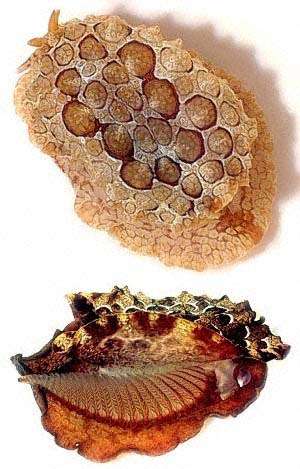
Pleurobranchus forskalii
(Ruppell & Leuckart, 1828)
Order: NOTASPIDEA
Superfamily: PLEUROBRANCHOIDEA
Family: Pleurobranchidae
DISTRIBUTION
Throughout the tropical Indo-West Pacific.
PHOTO
UPPER RIGHT: (upper photo)- Dorsal view of pale colour form, Mbudya Is, off Kunduchi Beach, Dar es Salaam, Tanzania, 80mm long,, June 1973. (Lower photo)- Right side view showing large gill, Fumba, Zanzibar, Tanzania, July 1971.
LOWER LEFT: Colour variation in animals from large population in sea-grass beds, Fumba, Zanzibar, Tanzania, July 1971.
LOWER RIGHT: Koumac, New Caledonia, October 1993.
PHOTOS: Bill Rudman.
This relatively large pleurobranch is often found in quite large populations in shallow lagoons, reef crests and pools and sea grass beds. It usually grows to about 10cm long but can grow to over 30cm. I know of no feeding reports for this species, but other species of Pleurobranchus are reported to feed on ascidians. While I was in Tanzania, a colleague, asked me if I had any idea of the identity of a pile of about 40 strange chitinous plates he had found in the stomach of a turtle. They were easily identifiable as the jaw plates of Pleurobranchus forskalii. As these photos show, this species is very variable in colour. The light brown colour form was originally described as a distinct species, Pleurobranchus semperi but anatomically it is identical to the dark purple-brown animals originally described as P. forskalii
In the above photo you can see the large gill, which as in all notaspids, is found on the right side of the body in the gap between the mantle and the foot. This is why some authors use the common name "Side-gilled Slugs" for this group of opisthobranchs.
Reference:
• Ruppell, E. & Leuckart, F.S. (1828). Neue wirbellose Thiere des Rothen Meeres. Atlas zu der Reise im nordlichen Afrika von Eduard Ruppell: 1-22.
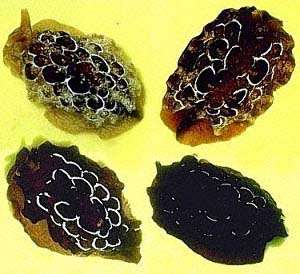
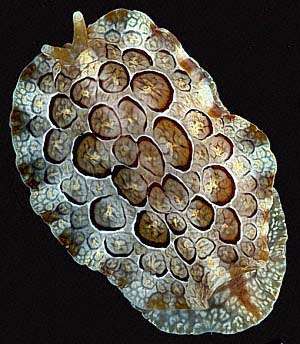
Rudman, W.B., 1999 (March 9) Pleurobranchus forskalii (Ruppell & Leuckart, 1828). [In] Sea Slug Forum. Australian Museum, Sydney. Available from http://www.seaslugforum.net/find/pleufors
Related messages
Pleurobranchus forskalii from Singapore
March 28, 2008
From: Ron Yeo
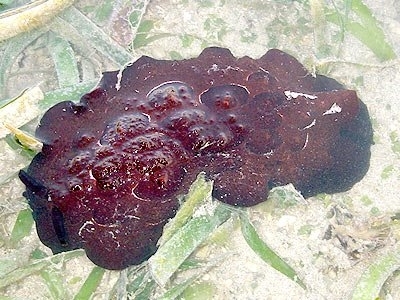
Dear Bill,
Found this huge slug among some seagrass on a reef flat. Thought it looks like a Pleurobranchus forskalii. Will really appreciate it if you can help to confirm the ID.
Locality: Cyrene Reef, 0m, Singapore, Straits of Singapore, 26 October 2007, Intertidal among seagrass. Length: 140 mm. Photographer: Ron Yeo.
Thanks a million!
Regards,
Ron
ronyeo@gmail.com
Yeo, R., 2008 (Mar 28) Pleurobranchus forskalii from Singapore. [Message in] Sea Slug Forum. Australian Museum, Sydney. Available from http://www.seaslugforum.net/find/21048Dear Ron,
Yes this is a dark form of P. forskalii.
Best wishes,
Bill Rudman
Pleurobranchus forskalii from Indonesia
February 15, 2007
From: Mirjam Broos

Dear Bill,
While diving in Sulawesi we found a few Pleurobranchus but I'm not sure what species they are. Can you help me with the ID please.
Locality: Ti Key 2, Lembeh Strait, North Sulawesi, Indonesia, 08 October 2006, muckdiving. Photographer: Geert Prast.
Thanks,
Mirjam
mirjam.broos@planet.nl
Broos, M., 2007 (Feb 15) Pleurobranchus forskalii from Indonesia. [Message in] Sea Slug Forum. Australian Museum, Sydney. Available from http://www.seaslugforum.net/find/19453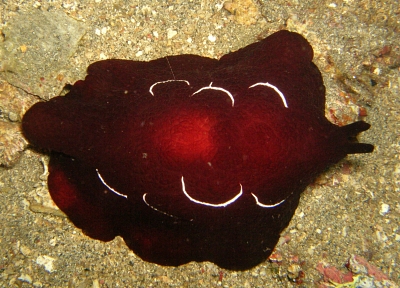
Dear Mirjam,
This is one of the colour forms of Pleurobranchus forskalii. The colour pattern ranges from very dark animals with white semi-circles like this to plain yellow-brown animals with dark brown rings.
Best wishes,
Bill Rudman
Swimming Pleurobranchus
June 20, 2006
From: Mark Schaer
When snorkeling at night (9PM), I saw a large sea slug swimming 1 meter below the surface. It was not moving much, rather drifting than swimming. Possibly it was about to feed from detritus that was floating at the surface there.
It resembled Pleurobranchus forskalii. It's color was brown, just darker than the picture in the Species list. I could not identify gills on the back of the animal, and there was a clear distinction between mantle and foot. The overall shape was oval. It was swimming in horizontal position, mantle up, foot down.
I have never heard of a large pleurobranch swimming and I could nowhere find a report about something similar. (No - it was not an andromeda jellyfish!)
Locality: El Quadim, El Quesir, 1, Egypt, Red Sea, 15.02.2006, swimming near riff border. Length: 12 cm
Thank you for any hint.
Mark Schaer
schaerm@freesurf.ch
Schaer M., 2006 (Jun 20) Swimming Pleurobranchus. [Message in] Sea Slug Forum. Australian Museum, Sydney. Available from http://www.seaslugforum.net/find/16893Dear Mark,
Various opisthobranchs can swim [see Fact Sheet for references] and there are photos and information on the Forum about two pleurobranch species, Euselenops luniceps and Pleurobranchus membranaceus, but I can't recall any record of P. forskalii swimming. That doesn't mean that P. forskalii doesn't swim, just that it hasn't been seen doing so before. It would be nice to confirm your observations
Best wishes,
Bill Rudman
A pleurobranch from Saipan
August 19, 2005
From: Takao Urasawa
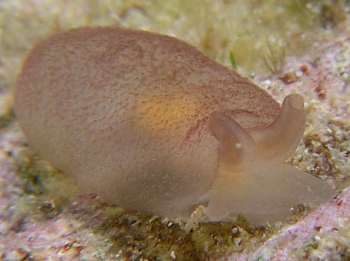
Dear sirs,
I think this is a kind of Pleurobranchidae. Could you tell me its real name ?
Locality: Laulau Beach, Saipan, CNMI-USA. Pacific Ocean Depth: 10 m. Length: 8 mm. 26 July 2005. under stone. Photographer: Ura
Takao Urasawa
dswith@isletwind.com
Urasawa, T., 2005 (Aug 19) A pleurobranch from Saipan. [Message in] Sea Slug Forum. Australian Museum, Sydney. Available from http://www.seaslugforum.net/find/14428
Dear Ura,
I am not sure if it is possible to be sure with such a small animal. I suspect it is a juvenile, and my best guess would be Pleurobranchus forskalii, but it could be one of a number of species. P. forskalii, can grow to 30 cm in length. I have included a close-up of the head alongside because it shows the typical rolled tentacles and oral veil very clearly
Best wishes,
Bill Rudman
Re: Mystery slug from Malaysia
May 10, 2005
From: Jimmy Goh
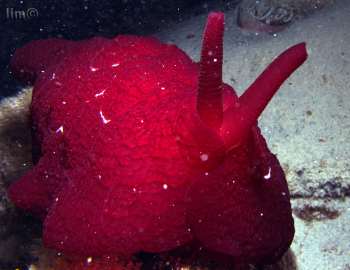
I have spotted a similiar slug that Michael have described [message #9456 ]. I have attached a photo and hope it might be the same one.
Locality: Pulau Dayang Jetty, Johor, West Malaysia. South China Sea. Depth: 10 m. Length: 200-300 mm. 26 Feb 2005. Sandy, under the Jetty
Photographer: Jim Goh.
Jimmy Goh
jimz19@singnet.com.sg
Goh, J., 2005 (May 10) Re: Mystery slug from Malaysia. [Message in] Sea Slug Forum. Australian Museum, Sydney. Available from http://www.seaslugforum.net/find/13735Dear Jim,
Although its a 2 year old mystery - thanks for helping to resolve it. As I said before, I think Michael's animal could be Pleurobranchus forskalii, and I am pretty sure your animal is as well. Pleurobranchus peroni can also be this colour but I don't know of any reports of it growing so large.
Best wishes,
Bill Rudman
Large pleurobranch from Malaysia
April 28, 2005
From: Alphonsus Jude Joseph
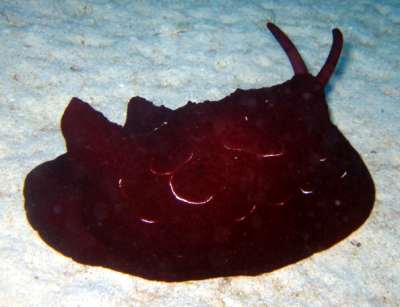
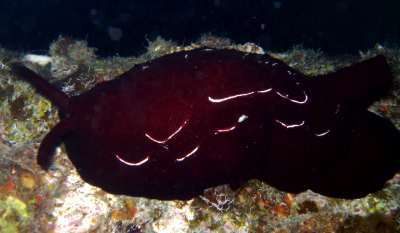
Found this big slug moving rather fast over a sandy bottom and it started climbing a jetty pillar. Any idea what slug this is? Around 25cm long.
Locality: Salang Jetty, Tioman, Malaysia. South China Sea. Depth: 18 metres. Length: 25 cm. 09 September 2004. Under Jetty. Photographer: Alphonsus Jude Joseph.
Alphonsus Jude Joseph
alphonjj@magix.com.sg
Joseph, A.J., 2005 (Apr 28) Large pleurobranch from Malaysia. [Message in] Sea Slug Forum. Australian Museum, Sydney. Available from http://www.seaslugforum.net/find/13654Dear Alphonsus,
I am pretty sure this is Pleurobranchus forskalii which can grow to about 30 cm in length. It ranges in colour from this dark brown form to a very light brown with dark brown markings. There is another species which sometimes looks quite similar, Pleurobranchus mamillatus, [see messages #10962, #2346] but that species has some very large conical papillae and I can't see any sign of them in your photos.
Best wishes,
Bill Rudman
Is this a sea slug?
February 2, 2005
From: Dominic Rutherford
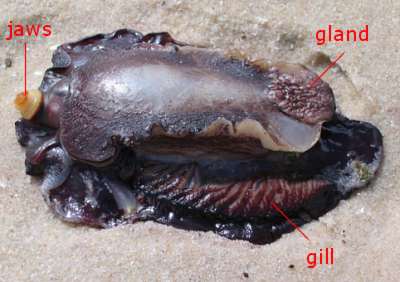
I saw this washed up on the beach on Benguerra Island, Mozambique in August 2004. I know very little about this kind of marine life, and have no idea what this could be.
Is this a sea slug?
Locality: Benguerra Island, Mozambique, Mozambique channel, Indian Ocean. Length: 9 inches (approx).14 August 2004. washed up at low tide. Photographer: Dominic Rutherford
Thanks.
Dominic Rutherford
seaslug@rutherfordfamily.plus.com
Rutherford, D., 2005 (Feb 2) Is this a sea slug?. [Message in] Sea Slug Forum. Australian Museum, Sydney. Available from http://www.seaslugforum.net/find/13071Dear Dominic,
Yes this is a sea slug. It is lying upside down in your photo and the large gill, I have labelled in red, identifies it has a pleurobranch slug, commonly called 'side-gilled slugs' because of this large gill which sits hidden under the mantle on the right side of the body. The gland I have labelled is the large pedal gland which these animals have at the posterior tip of the foot. The yellow bit poking out of the mouth are the pair of hard jaws which sit on either side of the mouth.
From its colour I suspect it a dark form of Pleurobranchus forskalii. I have been preparing some Fact Sheets on the pleurobranchs but the are not quite ready as yet
Best wishes,
Bill Rudman
Pleurobranchus forskalii from Lizard Is
January 10, 2004
From: Nils Anthes

Dear Bill,
Is this Pleurobranchus forskalii? The animal was only about 2cm long, but has a very neat colour pattern. Found at 2m on sand, Lizard Island (QLD, Australia), Dec 2003.
Best wishes
Nils
anthes@uni-muenster.de
Anthes, N., 2004 (Jan 10) Pleurobranchus forskalii from Lizard Is. [Message in] Sea Slug Forum. Australian Museum, Sydney. Available from http://www.seaslugforum.net/find/11843Dear Nils,
Yes this is the light colour form of Pleurobranchus forskalii.
Best wishes
Bill Rudman
Pleurobranchus forskalii from Sabah
July 23, 2003
From: Asther M. Lau
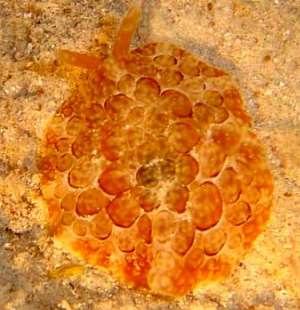
Hi!
Can you please identify this? Thanx!
Location: Lankayan, Sabah, Malaysia
Date: 30th April 2002
Photo: Lim Eng Hoo
Asther M. Lau
diveworldwide@yahoo.com
Dear Asther
This is Pleurobranchus forskalii
Best wishes,
Bill Rudman
Pleurobranchus forskalii from South China Sea
May 9, 2003
From: Audrey Koh
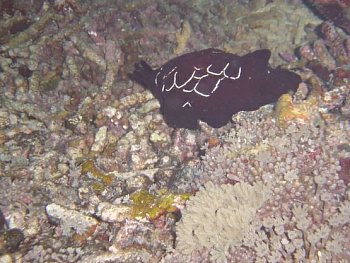

Hi there!
We were doing a liveaboard weekend to the Udang Oil Rigs on White Manta (www.whitemanta.com) and stopped to do an Exploratory Night Dive at Pulau Durai on our way back. It's the first time we have dived at this particular Island and we came across this huge sea slug. We were puzzled for a few days and did research to find out what it is. My day dive buddy, Maria, found a similar match on your web site. :-)
We were very excited about this finding and we hope that you could confirm what it is for us. My buddy, Peter, did more than 180 dives & I did more than 140 dives and this is the first time we saw it.
As I am an amateur photographer, the photos didn't come out well. It's really a bright burgundy red and it came out blackish red instead. :-( But I hope it will help start some documentation of findings in the South China Sea region. Here's more details:
Date/Time: 23 Apr 2003 20:05:48
Location: Pulau Durai, Anambas Islands, Indonesia, South China Sea- Found underneath a coral reef.
Colour: Bright Burgundy Red with White Patterns. Size: 25cm to 30cm. Water Temp: 29 - 30 Degree Celcius., Max Depth: 9 metres
I think it is Pleurobranchus forskalii?? Could you confirm please.
Audrey Koh
audrey_koh@hotmail.com
Koh, A., 2003 (May 9) Pleurobranchus forskalii from South China Sea. [Message in] Sea Slug Forum. Australian Museum, Sydney. Available from http://www.seaslugforum.net/find/9791Dear Audrey,
Yes this is the dark form of Pleurobranchus forskalii. It can grow to more than 30cm but is normally about half that size. Thanks for the information about yourself which I have added to the Participants List.
Best wishes,
Bill Rudman
Re: Mystery slug from Malaysia
March 27, 2003
From: Michael Smith
Dear Bill,
Thank you very much for your quick response. It is exactly what I was hoping for. On my next dive, I'll look for the side gill, squirting ink, etc. I'll also find out from the other divers if they took a good photo. By the way, that website is outstanding and I was already guessing it was one of the two Pleurobranchus you mentioned based on the information and pictures I found on the site. Your additional suggestions should
help nail it down.
Thanks again and regards,
Michael
zippsy@yahoo.com
Smith, M., 2003 (Mar 27) Re: Mystery slug from Malaysia. [Message in] Sea Slug Forum. Australian Museum, Sydney. Available from http://www.seaslugforum.net/find/9467Dear Michael,
I look forward to some photos - or a positive identification
Best wishes,
Bill Rudman
Mystery slug from Malaysia
March 26, 2003
From: Michael Smith
In the past eight months, I have seen many large slugs (measured from 20 to 30 cm) in waters off the west coast of penisular Malaysia. The slug is only seen at night and often a half dozen can be found during a single dive. No experienced diver recalls seeing these locally more than a year ago. They all appear as a solid dark red color and have the two "knobs" above the head but no other apparent marking (to my novice eye). Sorry that I can't give any more information until my next night dive; I am new at trying to identify things I see in the sea. If no one knows what these may be, maybe you can tell me what to look for next time. Just keep in mind that I can't tell a gill from a gall bladder so please talk to me like you would to your 12 year old child!
Thanks,
Michael Smith
zippsy@yahoo.com
Dear Michael,
Firstly is there any chance of a photo? As you say you're a novice, the biggest hurdle when trying to describe something in words is knowing what is important. Making a slightly educated guess from what you've told me - large and common, dark red, 2 knobs above the head. There are a few possibilities.
One is Pleurobranchus forskalii. If you look at that page in the Forum and the attached messages below you will see it ranges in colour from a light mottled brown to a dark red. Prod one and see if it has a large gill on the right side of the body below the mantle skin flap. Another possibility is Pleurobranchus grandis which has a similar colour range. Pleurobranchs always have a large gill on the right side of the body
Failing that you might have a Sea Hare. There is a lot on the Forum about these animals - which can be large and numerous. Go to the sea hare page for links to lots of information. One clue is that most species squirt out a purple ink if they are disturbed or prodded.
Let me know if any of these guesses are winners - but best of all see if you can send a photo
Best wishes,
Bill
Pleurobranchus forskalii from Lord Howe Island
January 28, 2003
From: W.B. Rudman
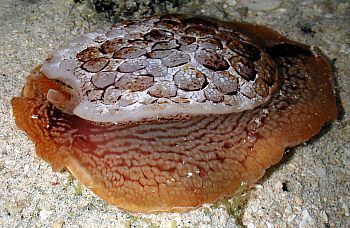
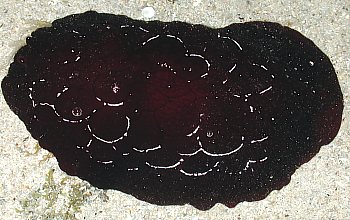
Here is a photo record from Ian Hutton of Pleurobranchus forskalii from Lord Howe Island.
Location: Far Rocks
This shows the range of colour variation found in the species.
Bill Rudman
Pleurobranchus forskalii from Solomons
July 14, 2002
From: Bruce Potter

Dear Bill,
On a night dive last week, we came across this Pleurobranchus. We commonly see a large plain red version of Pleurobranchus forskalii here, but have never seen this colour pattern before. It was only about 45mm long, whereas the red ones we usually see are from 70mm to 110mm. Is it possible that this is a juvenile colour form, or is it just different. It was on a sandy bottom at about 5m. this is on a dive site just near Honiara, Solomon Islands.
Regards
Bruce
bruce.potter@adventist.org.sb
Potter. B., 2002 (Jul 14) Pleurobranchus forskalii from Solomons. [Message in] Sea Slug Forum. Australian Museum, Sydney. Available from http://www.seaslugforum.net/find/6787Dear Bruce,
I haven't seen really small individuals of Pleurobranchus forskalii but by the time they are about 35mm long you can find all the colour varieties, so I don't think it is size related.
Best wishes,
Bill Rudman
Pleurobranchus forskalii from South Africa
January 3, 2001
From: Valda Fraser
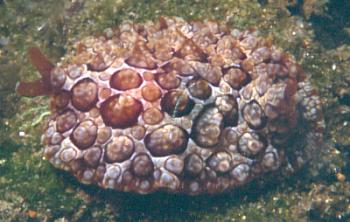
Dear Bill
I think this is Pleurobranchus forskalii . Please give your expert opinion.
Locality: Pumula, south coast KwaZulu-Natal, SOUTH AFRICA - intertidal zone
Date: December 200
Size: 50mm
Regards
Valda Fraser
valdafraser@mweb.co.za
Fraser, V., 2001 (Jan 3) Pleurobranchus forskalii from South Africa. [Message in] Sea Slug Forum. Australian Museum, Sydney. Available from http://www.seaslugforum.net/find/3465Dear Valda,
Yes this is P. forskalii.
Best wishes,
Bill Rudman
Pleurobranchus synonyms in South Africa
June 17, 2000
From: Ernest C.J. Seamark
I've been reading Macnae (1962) paper on Inhaca Island. I'm a bit confused as to which species he found is Pleurobranchus forskalii. He identifies a P. perrieri Vayssiere 1896, but does not describe the species only gives the reference to Vayssiere (1896), 126, pl. 4, 2-4, (1898), 321, pl. 13, 9, pl. 23, 127-134, pl. 26, 178. I have been unable to get hold of this reference, so as to confirm if this may be P. forskalii. Or is it P. inhacae Macnae 1962, where the description is similar but I would have thought more reference would have been given to the nodules on the mantle.
Thanks
Ernest C.J. Seamark
ErnestS@gpg.gov.za
Seamark, E.C.J., 2000 (Jun 17) Pleurobranchus synonyms in South Africa. [Message in] Sea Slug Forum. Australian Museum, Sydney. Available from http://www.seaslugforum.net/find/2564Dear Ernest,
Pleurobranchus perrieri is the name Vayssiere gave to the dark purple form of P. forskalii.
The other two species Macnae mentions:
• Pleurobranchus inhacae Macnae, 1962a: 174-176, Fig.5., Gosliner, 1987a: 58, Fig.58.
• Pleurobranchus xhosa Macnae, 1962a: 176- 177, Fig.6., Gosliner, 1987a: 59, Fig.61.
are I think, both juveniles of P. peroni. Certainly in eastern Australia and Tanzania I have found considerable colour variation among juveniles. MacNae mentions a much smaller prostate gland in P. inhacae than in P. peroni. This can be explained if they are juveniles.
The reference Ernest is referring to is:
Macnae, W. (1962) Notaspidean Opisthobranchiate Mollusca from South Africa. Annals of the Natal Museum, 15(15): 167-181.
Best wishes,
Bill Rudman.
Spanish Dancer with white eggs?
April 6, 2000
From: Jan Reyniers
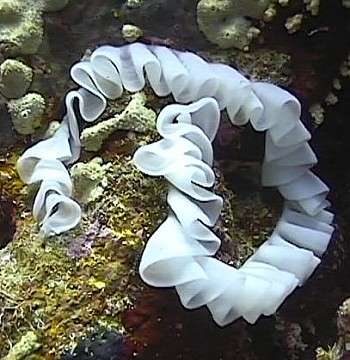
Hello ,
After visiting your webside I have a question about the Spanish Dancer eggs.
On my last trip to Egypt, [Ras Mohammed, Sinai], I found some eggs of a Spanish Dancer?? The only problem with these eggs is
that they are WHITE. Can you give me more information , or is this normal?
I've dived there for more than 300 times and this was the first time I saw them in this white colour. Or are they from another animal. The Depth was 18 meter and the egg-ribbon was about 30 cm in diameter.
Greetings,
Jan Reyniers
jan.reyniers@pandora.be
Reyniers, J., 2000 (Apr 6) Spanish Dancer with white eggs?. [Message in] Sea Slug Forum. Australian Museum, Sydney. Available from http://www.seaslugforum.net/find/2217Dear Jan,
From my own experience and from the literature (Gohar & Soliman - Red Sea; Francis - West Pacific), Hexabranchus sanguineus, the Spanish Dancer, has an egg ribbon which is bright pinkish red when laid, and changes to a reddish brown colour before hatching.
As you didn't see who produced the eggs and suggestion of mine is going to be a bit of a guess. My bet is that they are probably the eggs of Pleurobranchus forskalii. There is a photo of a section of its egg mass in the Forum. Apart from the similarity in shape, there are not many opisthobranchs large enough to produce an egg ribbon of 30cm diameter. I have seen shallow lagoons in Tanzania festooned with masses of P. forskalii produced by dense aggregations or assemblies of breeding adults all about 10cm long. Although the egg ribbons were often tangled, some isolated ones were more than 10cm in diameter. As Pleurobranchus forskalii can grow to about 30cm I assume it could produce an egg ribbon of similar diameter.
But I must warn you this is only an educated guess. I would welcome any more interesting finds you would like to share with us.
Best wishes,
Bill Rudman.
References:
•Francis,MP (1980) Habitat, food and reproductive activity of the nudibranch Hexabranchus sanguineus on Tongatapu Island. The Veliger 22(3): 252-258. (Figs 1-4)
•Gohar,HAF; Soliman,GN (1963) The biology and development of Hexabranchus sanguineus (Ruppell & Leuckart) (Gastropoda, Nudibranchiata). Publications of the Marine Biological Station, Al-Ghardaqa, Egypt, 12: 219-247.
Re: Notaspidean defensive secretions
May 14, 1999
From: Bill Rudman
Following Rhanor Gillette's recent message I asked her to send me a full citation of her paper on defensive secretions. It is:
Gillette, R., Saeki, M. and Huang, R.-C. (1991) Defense mechanisms in notaspidean
snails: Acid humor and evasiveness. Journal of Experimental Biology 156, 335-347.
Thanks Rhanor,
Bill Rudman.
Pleurobranch acid secretions
May 6, 1999
From: Rhanor Gillette
Hi, Bill.
We in this lab greatly enjoy your sea-slug forum. Thank you for maintaining it. I was interested in yours and others' observations on Pleurobranchus forskalii. Is this the species that can grow up to a foot?
I wonder how easily available this species is, were I to find myself on the Barrier Reef in Oz? I work on pleurobranchs (Pleurobranchaea californica mostly), and have a comparative study I do when possible (rarely). I once looked at acid secretion and how it is integrated into the animals' behavior in Pleurobranchaea, Berthella, Berthellina and Pleurobranchus sp. -- J. Exp. Biol. 156, 335-347 (1991) -- the skin pH drops to 1.5 pretty fast. Never could bring myself to taste the animals, ought to, I guess but I'll put it off. Weirdly, taurine at 0.1-10 mM concentrations in SW triggers it in Pleurobranchaea, and I've been wondering if it does it for all the pleurobranchomorphs (there is some kind of selective receptor), but its hard to get any other species here in the american midwest.
Regards,
Rhanor Gillette
University of Illinois at Urbana-Champaign
rhanor@life.uiuc.edu
Gillette, R., 1999 (May 6) Pleurobranch acid secretions. [Message in] Sea Slug Forum. Australian Museum, Sydney. Available from http://www.seaslugforum.net/find/843Dear Rhanor,
Glad you like the Forum. Pleurobranchus forskalii is usually found growing to about 10cm in length, but a few years ago in northern New Caledonia I was on a French Expedition where a couple of divers proudly returned with a couple of animals they had found in 12m which were 31cm long! So they definitely reach a foot in length. I must say I find animals growing that big a bit of a problem - too big to photograph, too big to dissect, too big to fit in any container etc. Those two, thanks to the insistence of Philippe Bouchet are now safely stored in a large polydrum in the bowels of the Paris Museum.
Concerning finding them if you are lucky enough to come to Oz. Well I have discussed this with a couple of experienced Great Barrier Reef collectors and their experiences are much the same as mine from East Africa. At times they can be very common (up to 10cm long) in shallow water back-reef - reef-flat regions, but there is no guaranteed time of year that you will find them. Sorry I can't be more deinite than that.
I would be interested in hearing of your work on Pleurobranchaea. Perhaps you could write an account for the Forum - even a review you've used for university report etc would be great. How do you work with these animals so far from the sea? Do you keep a breeding colony going or do you have to buy them from a commercial supplier?
Best wishes,
Bill Rudman.
Skin secretions in Pleurobranchus forskalii
April 30, 1999
From: Clay Bryce
Hi Bill,
I don't know if this is of any help but it is all useful info. With regards to K Koyanagi's query about Pleurobranchus forskalii. I have seen and photographed the effects of handling this species. It exudes copious amounts of acid (suplhuric?) in a mucous matrix that is strong enough to strip the outer skin layer from your hand. A burning sensation can be felt if the acidic mucous comes into contact with facial skin.
Cheers,
Clay Bryce
brycec@museum.wa.gov.au
Bryce, C., 1999 (Apr 30) Skin secretions in Pleurobranchus forskalii. [Message in] Sea Slug Forum. Australian Museum, Sydney. Available from http://www.seaslugforum.net/find/819Thanks Clay,
As you say, all information is useful. I remember the late Tom Thompson used to test slugs by touching his tongue to their skin - unofficially known as the 'Thompson Tongue Test'. I tried it on P. forskalii in Tanzania and resolved not to use the method again!
Best wishes,
Bill Rudman.
Pleurobranchus forskalii, P. peroni
April 29, 1999
From: K. Koyanagi
ID: Pleurobranchus forskali, Pleurobranchus peroni
Location: Hawaii(North Shore of Oahu)
I am interested in more background information on these two organisms. Where else can they be found? What do they eat? How can you tell what sex thay are? Are they toxic? Any information
Any help ASSP would be much appreciated.
K. Koyanagi
KYLE@AOL.COM
Koyanagi, K., 1999 (Apr 29) Pleurobranchus forskalii, P. peroni. [Message in] Sea Slug Forum. Australian Museum, Sydney. Available from http://www.seaslugforum.net/find/811Dear K. Koyanagi,
I'm afraid we don't know much about the biology of any species of Pleurobranchus. The two species your are interested in, Pleurobranchus forskalii and Pleurobranchus peroni are found throughout the tropical Indo-West Pacific and are sometimes found in large numbers on shallow reef flats.
All Sea Slugs are hermaphrodite, with a full complement of male and female organs. In Pleurobranchus they open on the right side of the body just in front of the gill. You can see the partly extended penis in the photo at the Top of this Page.
It is thought that all species of Pleurobranchus feed on ascidians (Sea Squirts), eating both solitary and compound species. However the European species, P. membranaceous, is the only species we have direct observations on.
Concerning their toxicity. Many Sea Slugs, including pleurobranchs, have secretory glands in their skin which are used for defence. The milky secretions of pleurobranchs are said to be quite acidic.
Any information you can collect on the basic natural history of these two species would be of interest. For example, What do they actually feed on? What do their egg masses look like? etc.
Best wishes,
Bill Rudman.
Pleurobranchus forskalii in South Africa
April 17, 1999
From: Ernest C.J. Seamark
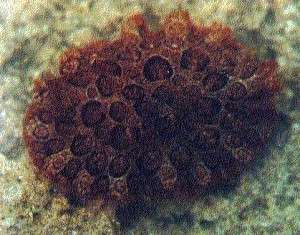
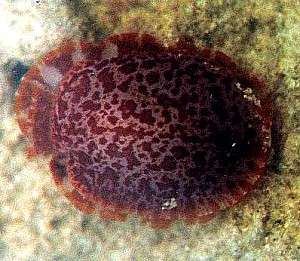
One specimen of Pleurobranchus forskalii was collected from within the intertidal zone of Treasure Beach, 6km south of Durban Harbour mouth, KwaZulu Natal, South Africa. On the 5 October 1998. If the ID is correct then this is the first record for South Africa, as it has been previously been recorded from Inhaca Island. [The lower photo is of the foot].
Please could you email your reply as I find it difficult to access the net and therefore the sea slug forum.
Ernest C.J. Seamark
kearneyt@biology.und.ac.za
Seamark, E.C.J., 1999 (Apr 17) Pleurobranchus forskalii in South Africa. [Message in] Sea Slug Forum. Australian Museum, Sydney. Available from http://www.seaslugforum.net/find/785Dear Ernest,
This is indeed Pleurobranchus forskalii. I guess like in New South Wales, here in eastern Australia, your are going to find tropical species some years, depending on the vagaries of the currents and water temperature.
Best wishes,
Bill Rudman.
Rudman, W.B., 1999 (Apr 17). Comment on Pleurobranchus forskalii in South Africa by Ernest C.J. Seamark. [Message in] Sea Slug Forum. Australian Museum, Sydney. Available from http://www.seaslugforum.net/find/785Opisthobranchs from Durban, South Africa
March 13, 1999
From: Ernest Seamark
I have for the past 3 years been collecting and photographing Opisthobranchs from Durban, KwaZulu Natal, South Africa. At a site about 1km south of Durban Harbour mouth. I'm an education officer and the learners who I teach on the ecology of the rocky shore (inter-tidal zone)regularly pick up strange opisthobranchs, amongst other creatures.
I have collected about 55 different species of opisthobranchs, but have only been able to ID about 27, using Gosliner's key on the Nudibranchs of Southern Africa. I have found that his key is not conclusive as many of the specimens that I have are not found in the book. Using this web site I have just ID Pleurobranchus forskalii (Ruppell & Leuckart, 1828) or one that is very similar from Southern Africa and I believe this is a new distribution of this species.
This is a long message, but if you are intrested in material or I can try and digitize my slides using a camera and send them to you. The specimens are to be lodged with the Natal Museum (Dr Dai Herbert), I'm in the process of handing them in.
The email is a friends so I may take some time to answer normally about a week that is if I'm not in the field as my other study area are bats.
Ernest C.J. Seamark
kearneyt@biology.und.ac.za
Seamark, E.C.J., 1999 (Mar 13) Opisthobranchs from Durban, South Africa . [Message in] Sea Slug Forum. Australian Museum, Sydney. Available from http://www.seaslugforum.net/find/674Dear Ernest,
I am not sure if Pleurobranchus forskalii has been reported from South Africa before but MacNae (1962) reported the dark form from Inhaca Bay, Mozambique. Like the New South Wales coast of eastern Australia, the northeastern coast of South Africa must get a regular influx of more tropical species courtesy of the southward, if irregular movement of coastal currents.
If you have have photos of other species I would be happy to put them on the Forum. With the help of Terry Gosliner, I am sure we would be able to help you out and also provide information for other people interested in your fauna. If scanning is a problem, if you post the slides to me I can scan them here and return them to you.
Best wishes,
Bill Rudman
